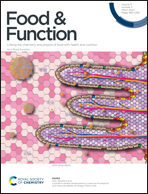Effect of the carrier material, drying technology and dissolution media on the viability of Lactobacillus fermentum K73 during simulated gastrointestinal transit†
Abstract
The goal of this study was to determine the effect of the carrier material, drying technology and dissolution media during the passage of L. fermentum K73 through a dynamic in vitro digestion system (IViDiS). The carrier materials were (i) culture medium with growing micro-organisms and (ii) culture medium with maltodextrin : sweet whey [0.6 : 0.4]. The carrier materials were dried by spray-drying and freeze-drying to obtain four types of powders. The dissolution media consisted of water and 1% fat milk. The powders were tested using an in vitro dynamic digestion system (IViDiS). The results showed that powders derived from culture medium had the highest protective effect on the viability of L. fermentum K73 in both dissolution media and that survival increased when the powders were tested in milk. The modified Gompertz model was used to model L. fermentum K73 behaviour during the digestion process. The model showed that cells entrapped in culture medium had the longest lag phase and the slowest inactivation rate when evaluated in milk.



 Please wait while we load your content...
Please wait while we load your content...